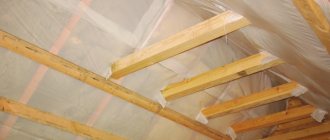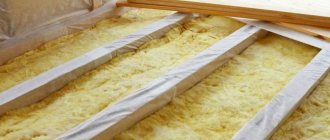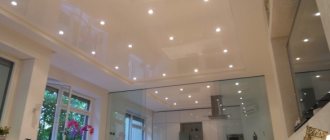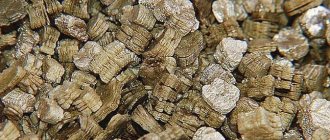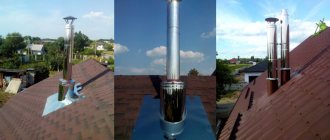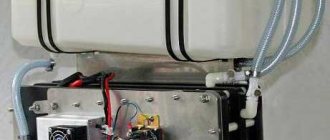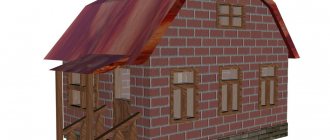Thermal insulation of an attic in a private house
During thermal insulation work, walls are usually insulated. But it should be remembered that it is through the attic that about half of the heat is lost, and there are often cases when, without proper insulation, owners of private houses have many problems with dampness, etc.
On a note! Warm air in the room rises to the top. If you do not take care of proper insulation in advance, the moisture level will increase. These are favorable conditions for the development of mold.
Knowing how to insulate an attic in a private house, you can prevent these problems. And in winter, the temperature in the house will noticeably increase to a comfortable level.
The technology for self-insulation of the attic includes only 3 stages of work:
- Insulation of the ceiling.
- Roof insulation.
- Insulation of gables.
To carry out this work without large financial costs, without losing quality, you need to know the features of insulation materials. Each of them is designed for specific operating conditions and installation methods.
The first thing you need to do is insulate the ceiling Source serviceseeking.com.au
How to insulate a floor at minimal cost
This insulation stage consists of 3 steps:
- Preparation of the necessary materials;
- Floor preparation;
- Insulation of the ceiling.
First you need to decide how to insulate the attic in a private house. Independent work means saving money, which is why you should familiarize yourself with the list of inexpensive materials.
What to choose for attic insulation
How to insulate the attic in your home without special expenses - 5 materials to choose from with different levels of thermal conductivity:
- sawdust (0.07-0.095 W/(m*k));
- reed (0.042 w/(m*k));
- expanded clay (0.1-0.18 W/(m*k));
- penoizol (0.028-0.040w/(m*k));
- mineral wool (0.038-0.055 W/(m*k)).
Advice! When choosing how to insulate an attic in a private home inexpensively, you should focus your attention on the first two materials. Their peculiarity is that you can get them absolutely free.
Insulation mats made from reed stems are excellent for thermal insulation of the attic Source pinimg.com
However, when working with these materials, certain conditions must be observed. If it is sawdust, then it must be dried and processed before use. Any antiseptic agent is suitable for treatment, including slaked lime mixed with carbide.
Attention! Any wood material is susceptible to fungus. If traces of mold or rot are found on the sawdust, it is better to simply throw them away. This material is no longer used for thermal insulation.
It is advisable to harvest reeds in the fall. At this time, the stem is already completely freed from foliage, changing its shade to light yellow. It should be remembered that immature reeds should not be used in the work.
Expanded clay is considered a relatively inexpensive material, since its cost does not exceed 1000 rubles per cubic meter. However, for high-quality insulation of the attic you will need a 20-centimeter layer.
It is important to know! The main advantage of expanded clay in comparison with the materials described above is fire safety. If a fire occurs, this insulation will not ignite.
Penoizol is a little more expensive than expanded clay. Its price is 2000-2300 per cubic meter. But there is a significant drawback in working with this material. To use penoizol, special equipment is required, i.e. You won’t be able to cope with insulation on your own
Insulation with penoizol using special equipment Source instrumentgid.ru
See also: Catalog of companies that specialize in insulating houses and roofs
Penoizol is characterized by three advantages:
- fire safety;
- waterproof;
- resistance to fungi.
The same qualities are characteristic of mineral wool. The material benefits only by its environmental friendliness. At the same time, the price is slightly higher - up to 2500 rubles.
Knowing how to insulate the attic of a private house, you can purchase other necessary materials. These include a vapor barrier membrane. It prevents steam from accumulating. It is also necessary to purchase additional boards or OSB sheets. For the last stage of processing, you will need a solution with antiseptic properties.
How to prepare the floor for work
Preparation for floor insulation is done in 3 steps:
- Dismantling.
- Treatment.
- Binder.
Old beams usually have a deck on them. If you want a high-quality result, you need to understand that you cannot immediately apply insulation to such a surface.
The old coating and all the rubbish need to be removed Source bytrf.ru
Attention! Wooden beams require mandatory impregnation with an antiseptic. To do this, you need to take the prepared product and treat the surface with it. Otherwise, there is a risk of fungal infection.
To properly impregnate wood with an antiseptic solution, you should pay attention to the instructions. The manufacturer of such formulations provides step-by-step instructions on the back of the package.
The last step involves preparing the binder (or roll). It's easy to do it yourself. You only need nails to nail the boards to the surface.
When the ceiling is prepared, you can move on to the next stage Source buildhome.semtex.ru
The main advantages of attic insulation
Layers of Insulation Before Laying the Floor
The benefits of properly insulating your loft are well known. First of all, it is about maintaining heat in the house. There are also other factors to consider, such as the health of you and your loved ones.
Proper attic insulation can bring many benefits to you, your family and your home.
1. Save money on electricity and gas bills
Better attic insulation saves you money. After all, a poorly insulated house can lose a quarter of its heat through the roof.
The simple solution is to install appropriate insulation
If this insulation is the recommended thickness of 270mm, you could save up to 25% on your electricity or gas bills.
Good insulation increases the value of your home
Improving the energy efficiency of your home makes it more valuable. According to statistics from completed home purchase and sale transactions, real estate with energy-saving technologies was sold at an average of 14% higher price.
Properly installed insulation can improve your health
A damp problem can affect your health or the health of other family members.
Poorly insulated attics and those where flooring is installed incorrectly can cause damp and condensation. This can lead to mold which, along with dampness, means you are more likely to have respiratory problems, respiratory infections, allergies or asthma.
Problems often arise when insulation is compressed by improperly installed attic flooring. This will stop the air flow between the floor and the insulation.
It is important to lay a solid base on top of the insulation
This can lead to problems such as:
- The insulation loses its thermal efficiency.
- This causes cracks in the ceiling.
- Water vapor generated in the home rises until it hits the cool surface of the lower attic floor.
- This may cause condensation to form inside the insulation.
- The condensation then begins to seep down, creating dampness and affecting the ceilings.
If you want to use your attic space for storage, adequate air flow is essential. This should be considered an absolute necessity.
Helps the environment
A properly insulated private home can reduce CO2 emissions by up to 80kg per year. Reducing CO2 emissions means you are doing your part to reduce global carbon emissions. And therefore the consequences of climate change.
Reduced wear and tear on your boiler
- If your boiler has to produce more heat than it needs, consider it won't last as long as it could.
- Having proper attic insulation means that you will create a stable living environment inside your home.
- This will help extend the life of your boiler, which is another way to save money!
Video description
Watch this video on how to properly insulate a floor:
Roof insulation
This stage of work is optional, since roof insulation is required only for residential attics. If the rooftop room will be used as a separate room, then the necessary materials should be prepared.
To insulate the roof you will need the following tools:
- nails;
- threads;
- vapor barrier;
- antiseptic;
- wooden slats.
Advice! For those who want to save money, we recommend using reeds at this stage. It can be used to make good thermal insulation mats.
Roof insulation, similar to the previous stage, involves the preliminary purchase of materials, preparation of the surface itself and the main thermal insulation process. If you are considering options for making a warm attic, you need to study the technology of working with roofing.
Preparing the roof for insulation
The roof preparation process consists of 3 simple steps:
- Inspection.
- Extension.
- Treatment.
Surface inspection involves a detailed analysis of the integrity of the rafter system with subsequent repair or replacement of unsuitable parts. This is especially important if cracks or rot have been noticed.
In this case, a complete update of the damaged elements is required Source roofs.club
Video description
Watch this video for possible errors and their correction when insulating the roof:
Attention! It is important to monitor the density of the thermal insulation material. The further result depends on this. If gaps form in the insulation, they must be filled. This can be done using scraps of thermal insulation.
You also need to remember about fixing the insulation. To do this, you need to drive nails into the rafters and once again tighten the threads in a zigzag. Upon completion of the process, you need to make the sheathing using slats or boards. Their thickness should be at least 2 cm.
Insulation of gables
Pediments are usually insulated from the outside together with the facade. But if this work is not planned, you can make thermal insulation from the inside.
Attention! To insulate the gables you will need beams. If they are not there, you can replace the material with boards. In this case, it is necessary to measure their width so that it matches the width of the heat-insulating material.
Gables can be insulated using dry blowing. Source oboiman.ru
To insulate gables, you should follow 6 steps:
- Fastening on the surface of the slats to ensure ventilation between the heat-insulating material and the wall (in this case, you must adhere to the distance parameters - half a meter vertically, about 10 cm horizontally);
- Placement of the vapor barrier membrane on a plane of slats (here you should pay attention to the position of the slats and correct unevenness, and the film should not sag);
- Installation of vertical racks in the form of beams or boards, followed by fastening with screws and metal corners (it is necessary to compare the distance between the beams - it should be 2 cm less than the width of the insulation);
- Filling the space with heat-insulating material (the insulation should fit tightly - this is an indicator of the correctness of the previous steps; if the mats fit easily, then additional reinforcement will be required);
- Re- attaching the vapor barrier ;
- Installation of sheathing.
After all the work has been completed, you can begin the final finishing of the room. Before purchasing material, you should analyze the further use of the room. For residential attics, drywall and finishing putty are suitable.
Advice! If the attic is cold, you should give preference to materials designed for low temperatures. The finish will quickly deteriorate if operating conditions are not followed.
Ceiling insulation
Let's consider the process of insulating the attic ceiling with mineral wool. The technology varies based on the specific designs and circuits chosen.
Outside
The simplest and fastest method of thermal insulation is inter-beam. If the ceiling is made of solid boards, a vapor barrier must be placed around the beams or film wraps must be made on them. If the ceiling is made of thin lining or slats, a foil vapor barrier film is attached below the beams, along the ceiling.
Methods for insulating a wooden ceiling from the attic
A complete insulation scheme requires significantly more labor, materials and time, but it is also much more effective. An above-beam double layer of slabs is added to the inter-beam layer of rolls or mats. The layers must be laid overlapping.
How to insulate a cold ceiling from the inside
When choosing a method of thermal insulation of the ceiling from the inside, you need to understand that any of them will reduce the height of the room. Minimal height loss will occur in the case of installing a suspended ceiling or suspended ceiling made of plasterboard. In this case, thermal insulation boards can be placed between the guide metal profiles.
Fastening basalt wool to disc dowels
If a suspended ceiling is not planned, then insulation boards can be attached in various ways:
- Still, make guides from wooden slats or metal profiles.
- Secure the panels with special disc dowels. For one mat measuring 1200 * 600 mm you need at least 4-5 dowels
- Glue to the ceiling with mastic.
A reinforced mesh is glued to the lower part of the insulation, and leveling primer and layers of paint are applied to it.
No attic
When insulating buildings without an attic, in addition to solving the problem of heat preservation itself, it is necessary to ensure the removal of excess moisture, both contained in the air in the form of vapor and condensing on cold surfaces.
Scheme for buildings without an attic
A vapor barrier is laid under the light ceiling, and a layer of thermal insulation material is laid on it. It is necessary to provide two ventilated gaps - between thermal insulation and waterproofing and between waterproofing and roofing material. You need to install vents along the ridge or simply lift the ridge cap so that the air can escape freely.
Briefly about the main thing
Thermal insulation of the attic, like any other construction work, requires calling specialists. If you want to save money and have the necessary skills to work with tools, then you can try to do it yourself.
When choosing how to insulate an attic, you first need to decide on the material. At this stage, it is important to consider the further use of the premises, as well as correctly calculate your budget.
There are many thermal insulation materials. The cheapest of them are sawdust and reeds. Expanded clay, penoizol and mineral wool are a little more expensive. They have better quality properties.
Thermal insulation is carried out in three stages - insulation of the ceiling, then the roof and gables. In the process of insulating the attic yourself, it is important to follow the instructions presented above with all the recommendations. The result of the next one depends on the quality of one stage.
Ratings 0
Insulation using expanded clay
Expanded clay is used to insulate attic floors in cases where heat losses in the house are insignificant and you can get by with a small amount of insulation so as not to weigh down the load-bearing structure.
Expanded clay has many advantages over other insulation materials: it is inedible for rodents, durable and, since it is bulk insulation, it easily fills all the unevenness and hard-to-reach places on the surface. To ensure that there are no voids left when insulating with expanded clay, granules of different sizes should be used.
In addition, expanded clay is not afraid of moisture, so it does not need to be protected from it and you do not need to spend money on purchasing waterproofing material.
However, the thermal insulation characteristics of this material are relatively low, so for greater efficiency you will still need to pour a fairly thick layer, which will increase the load on the floors of the house. In this case, it is recommended to combine expanded clay with mineral wool, which will make it possible to make multi-layer insulation, making it somewhat lighter due to lighter mineral wool.
The technology of insulation using expanded clay is quite simple:
You need to pour a layer of insulation onto the attic floor that has been cleared of debris, and then cover it with a cement-sand mortar screed. In the attic, which is subsequently planned to be used as a living space, you can lay laminate or linoleum on top of the finished screed, or limit yourself to flooring made of boards or wood boards.
If there are communication pipes in the attic, they can also be insulated with expanded clay, which will provide the ventilation necessary in such places and protect the structure from fire if the pipes become very hot.
When combining expanded clay with mineral wool, you will need to use an insulating film to protect the structure from moisture. First, the floor is covered with a vapor-proof material, then a layer of expanded clay is poured onto which lathing and mineral wool slabs are laid, and another layer of film is laid on top.
After this, you can make a flooring from boards or other material to cover the floor.
